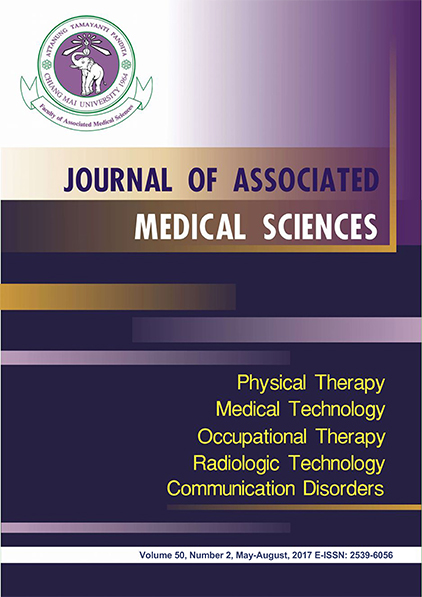Knowledge, attitude and risk behavior regarding HPV infection among senior students of Chiang Mai University
Main Article Content
Abstract
Background: Human papillomavirus (HPV) is common sexually transmitted in Thailand. The incidence of HPV infection is currently increasing among adolescents and is likely to increase gradually. Senior students of the university are prompt to start a family or working. They should, therefore, have knowledge about prevention of HPV infection in order to reduce rate of HPV infection.
Objectives: To evaluate knowledge, attitude, and risk behavior of HPV infection. Investigation of the association compared to knowledge, attitude and risk behavior of HPV infection of senior students of Chiang Mai University was also focused.
Materials and methods: This study was a descriptive study. Data was collected from 378 senior students of Chiang Mai University using questionnaire. The student were divided into three groups: 108 students from Health Sciences, 108 students from Science and Technology, and 162 students from Social Sciences and Humanities.
Results: The results were tested with a statistically significant difference at the level of p=0.05. Students from Health Sciences had more knowledge (p<0.001) and attitude (p=0.002) than other groups. It was shown that level of knowledge was related to level of attitude (p=0.003). A correlation between high-risk behavior and HPV infection were found in students from Social Sciences and Humanities who had highest risk behaviors and highest experienced sexual intercourse (p=0.006).
Conclusion: All groups of students should be developed in knowledge and attitudes about HPV. Less than 50 percent of students in each group had good knowledge and attitude. It meant that they have good knowledge and a sensible attitude which lead to good sexual behavior.
Journal of Associated Medical Sciences 2017; 50(2): 176-186. Doi: 10.14456/jams.2017.15
Article Details

This work is licensed under a Creative Commons Attribution-NonCommercial-NoDerivatives 4.0 International License.
Personal views expressed by the contributors in their articles are not necessarily those of the Journal of Associated Medical Sciences, Faculty of Associated Medical Sciences, Chiang Mai University.
References
2. Tong W, Hillman R, Kelleher A, Grulich A, Carr A. Anal intraepithelial neoplasia and squamous cell carcinoma in HIV-infected adults. HIV Med 2014; 15: 65-76.
3. Munoz N, Castellsagué X, de González AB, Gissmann L. HPV in the etiology of human cancer. Vaccine 2006; 24: S1-S10.
4. National Cancer Control Programmes [Internet]. Thailand: National Cancer Control Programmes; 2013 [cited 2016 Jan 17]. Available form: http://www.nci.go.th/th/File_download/D_index/NCCP_2556-2560.pdf.
5. Bedford S. Cervical cancer: physiology, risk factors, vaccination and treatment. Br J Nurs 2009; 18: 80-4.
6. Bleyer A, O’leary M, Barr R, Ries L. Cancer in Adolescents and Young Adults. Switzerland: Springer International Publishing; 2006.
7. Markowitz LE, Dunne E, Saraiya M, Lawson H, Chesson H, Unger E. Quadrivalent human papillomavirus vaccine. Morbidity and Mortality weekly report 2007; 56: 1-24.
8. Bureau of Policy and Strategy Ministry of Public Health [Internet]. Thailand: Bureau of Policy and Strategy Ministry of Public Health; 2013 [cited 2015 Sep 6] Available form: http://bps.ops.moph.go.th/Healthinformation/%E0%B8%AA%E0%B8%A3%E0%B8%B8%E0%B8%9B%E0%B8%AA%E0%B8%96%E0%B8%B4%E0%B8%95%E0%B8%97%E0%B8%B5%E0%B9%88%E0%B8%AA%E0%B8%B3%E0%B8%84%E0%B8%B1%E0%B8%8D%20%E0%B8%9E.%E0%B8%A8.%202556.pdf
9. Muñoz N, Méndez F, Posso H, Molano M, van den Brule AJ, Ronderos M, et al. Incidence, duration, and determinants of cervical human papillomavirus infection in a cohort of Colombian women with normal cytological results. J Infect Dis 2004; 190: 2077-87.
10. Yamane T. Elementary Sampling Theory. New York: Prentice Hall; 1967.
11. Phianmongkhol Y, Suwan N, Srisomboon J, Kietpeerakool C. Knowledge about human papillomavirus infection and cervical cancer prevention among nurses in Chiang Mai University Hospital, Thailand. Asian Pac J Cancer Prev 2011; 12: 823-5.
12. Bloom B.S. Mastery Learning UCLA – CSEIP Evaluation Comment [Thesis]. University of California at Los Angeles; 1968.
13. Likert R. Attitude Theory and Measurement. New York: Wiley & Son; 1967.
14. Best J.W. Research in Education. New Jersey: Prentice Hall Inc; 1997.
15. Frederic K.G, Richardson M.W. Psychometrika. USA: Springer US; 1937.
16. Fisher R. Statistical methods and scientific induction. J R Stat Soc Series B Stat Methodol 1955; 17: 69-78
17. Juntasopeepun P, Suwan N, Phianmongkhol Y, Srisomboon J. Knowledge and Risk Behaviors of HPV Infection and Cervical Cancer among Female College Students: Implications for Sex Education and Health Care Policy. Thai J Nurs 2011; 26: 48-62. (in Thai)


